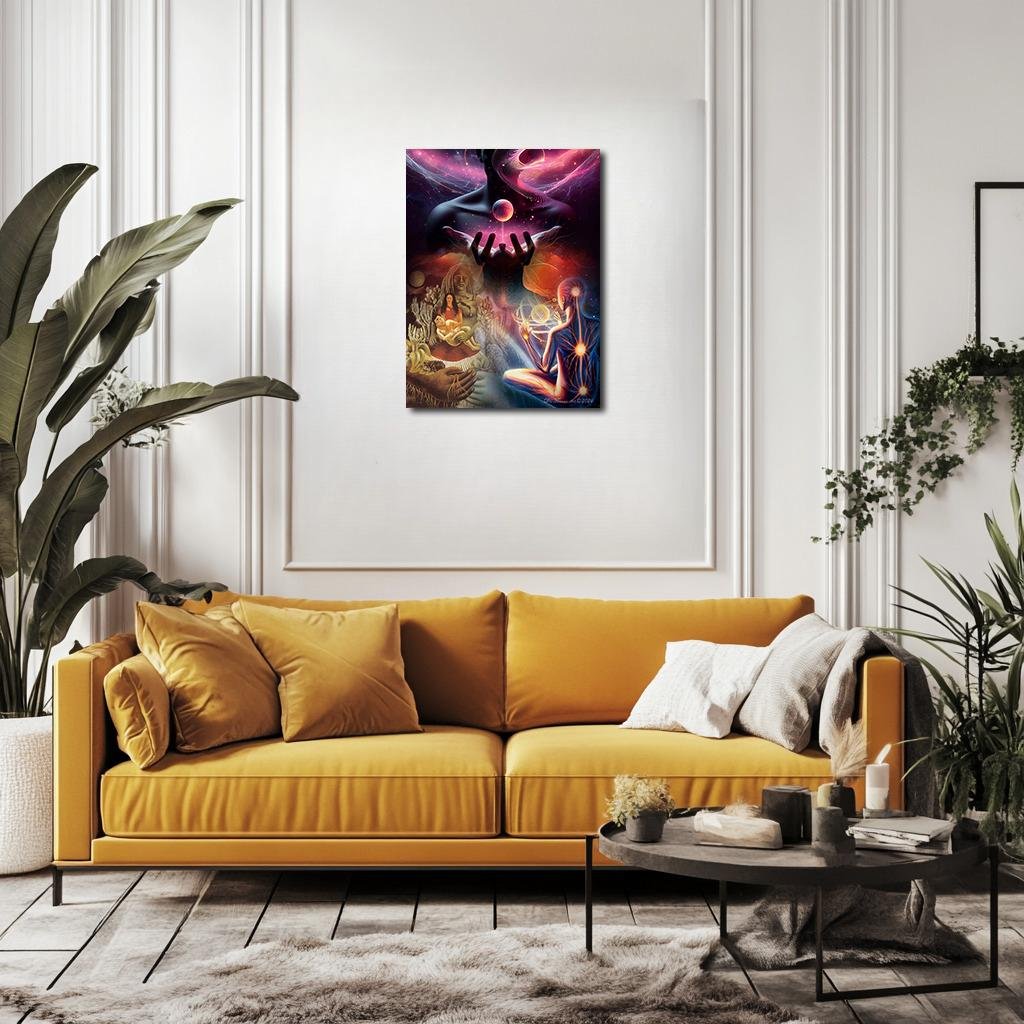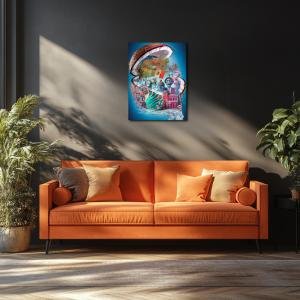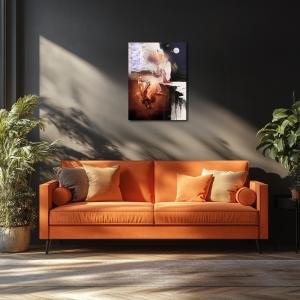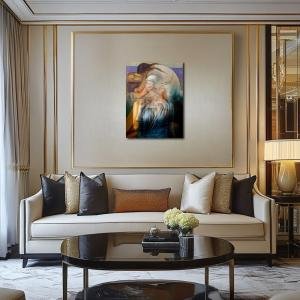The Cosmic Cradle: Frida’s Eternal Embrace
The Cosmic Cradle reimagines Frida Kahlo’s The Love Embrace of the Universe as a transcendent spiral of maternal earth, inner light, and celestial unity. Through radiant violets, golden browns, cosmic pinks, and stone-carved skin, Frida, Diego, and the Earth deity dissolve into a sacred continuum. Above them, a divine figure holds a glowing planet in outstretched hands, while a meditating soul glows in radiant stillness. This work is not about connection—it is connection, a dream of the body as cosmos, of Kahlo as the pulse between breath and stars.
Please see Below for Details…
Hotline Order:
Mon - Fri: 07AM - 06PM
404-872-4663
This conceptual reimagining of Frida Kahlo’s The Love Embrace of the Universe, the Earth (Mexico), Myself, Diego, and Señor Xólotl transforms her original vision of interconnectedness into a radiant, spiritual mandala of celestial balance, maternal surrender, and divine absorption. Titled The Cosmic Cradle , this work expands the boundaries of Kahlo’s layered intimacy by dissolving the self into galaxies, wombs, and infinite spirals of becoming. It is not a portrait of love in parts—it is the totality of union: earth to sky, woman to man, self to spirit.
At the heart of the composition rests the familiar trio from Kahlo’s original: Frida, Diego, and the mother-earth deity holding them. They now appear nestled within a womb-like terrain of roots and lunar light, grounded in soil but watched by planetary orbs that drift upward into stellar bodies. Their form is rendered in soft sandstone, their outlines glowing with tenderness. The love here is not romantic—it is generative, protective, eternal. Diego’s third eye glows faintly on his forehead, while Frida’s arms cradle him with a stillness that recalls ancient icons of motherhood and surrender. Behind them, cactus, roots, and warm desert stones extend like the veins of the world itself.
Above them, a vast cosmic figure emerges, genderless and infinite, its chest opened to a swirling nebula of energy and breath. The figure raises cupped hands to hold a glowing planet—perhaps Earth, or perhaps the seed of all human memory. Their posture is not one of offering, but of reverence. Their head tilts upward, mouth open as if in ecstatic silence, allowing constellations and solar winds to flow through. The chest radiates with soft gradients of rose, indigo, and ultramarine, the deep hues of creation energy and sacred transition. These colors pulse gently, as if mimicking the rhythm of inhalation.
To the right of the cosmic cradle, a meditative figure sits cross-legged in contemplation, its outline illuminated by glowing chakras—points of orange, violet, and gold that anchor the viewer in a map of inner understanding. The figure’s gaze is fixed not outward, but inward—toward orbs that float like thoughts or celestial bodies within its aura. These elements form a dialogue between the personal and the galactic, the flesh and the ether, Kahlo’s body and the spirit she so often ached toward.
The color composition of The Cosmic Cradle speaks in gradients of duality and union. The lower half breathes in warm, earthen tones: burnt umber, sun-touched ochre, and the golden blush of desert moonlight. These are the tones of body, birth, gravity, and maternal flesh. Frida’s skin radiates in reddish bronze, pulsing with life even in repose, while the stone goddess behind her reflects the colors of sandstone temples, blood-soaked rituals, and feminine permanence. Plants are painted in dusty green and copper, connecting the figures to life’s constant becoming.
The upper half is a dream of cool celestial brilliance. Shades of deep violet, electric indigo, soft lavender, and black sapphire form the firmament above the embrace. These colors evoke the inner eye, the sacred unknown, and the nocturnal mind. Swirls of magenta and cosmic pink wrap around the universe’s torso like the Milky Way draped in silk. A glowing planet held in dark hands shines in radiant coral and celestial peach, its surface warm with promise, its glow reflecting back on the divine figure’s outstretched arms.
The meditative figure on the right glows in solar golds and crystalline blues, their body a constellation of knowing, seated calmly between galaxies. Their presence echoes Kahlo’s own longing for integration—her sense that true identity lies not in the body alone, but in energy, orbit, and vibration.
When I created The Cosmic Cradle , I wanted to honor Kahlo’s original embrace not as a fixed scene but as a sacred pulse—an ever-expanding mandala where all beings, from gods to lovers to soil-dwelling roots, are woven into the same tapestry. Frida understood pain not just as suffering, but as a gateway to knowing one’s place in the whole. In her painting, the Earth is not passive—it holds, breathes, nourishes. Diego is not dominant—he is held. And Frida, who is so often seen in isolation, is here the central vessel of love, transmission, and unity.
The composition flows in gentle waves: from the mother-rooted bottom, through the human heart embrace, into the meditative glow, and upward into cosmic surrender. It is the journey of the self through layers of love, through the breaking of boundaries, into luminous peace.
In this vision, Frida Kahlo is not only the woman being held—she is the planet, the gesture, the spiral of becoming. She lives in the roots and in the stars, reminding us that we are not merely bodies in a landscape—we are landscapes in a body, forever seeking and forever held.
Add your review
Your email address will not be published. Required fields are marked *
Please login to write review!
Looks like there are no reviews yet.








